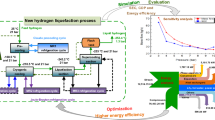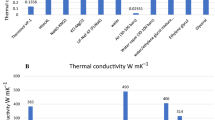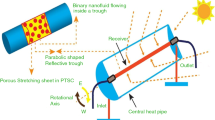Abstract
Vapor–liquid equilibrium (VLE) data plays a vital role in the design, modeling and control of process equipment. In this study, to estimate the VLE data of binary systems, a deep neural network (DNN)-based combining rule was proposed based on the cross-term parameter \((a_{ij})\) in the two-parameter Peng–Robinson cubic equation of state (PR-EoS) combined with the one-parameter classical van der Waals mixing and combining rule (1PVDW). Experimental VLE data of alternative binary refrigerant systems selected from the literature were calculated using both the PR + 1PVDW and the DNN-based model. Vapor phase mole fractions \((y_i)\) and equilibrium pressures (P) obtained from the proposed DNN-based and PR + 1PVDW models were compared in the terms of average percent deviations. For the DNN-based model, the vapor phase mole fractions give at least as good results as the models in the literature, and also it has been shown that a much better estimate of the equilibrium pressure (P) is obtained when compared with that of the literature. Results obtained using the proposed DNN-based model are presented with tables and graphs. For the equilibrium pressure, while the average percent deviation errors \((\Delta P/P \%)\) calculated in the literature are less than 7.739, the errors obtained with the proposed DNN-based model are smaller than 3.455. And also, for vapor phase mole fractions, while the maximum error \((\Delta y_1/y_1 \%)\) in the literature is obtained as 6.142, the largest error calculated with DNN-based model is 3.545. It has been seen that the proposed DNN-based model makes more practical and less error-prone estimations than the methods in the literature.









Similar content being viewed by others
Data availability
All data are cited in the Table 1 and Reference List.
Abbreviations
- EoS:
-
Equation of state
- DNN:
-
Deep neural network
- GA:
-
Genetic algorithm
- OF:
-
Objective function
- PR:
-
Peng–Robinson
- ReLU:
-
Rectified linear unit
- vdW:
-
Van der Waals
- VLE:
-
Vapor–liquid equilibrium
- 1PVDW:
-
One-parameter classical van der Waals
- a(T):
-
Energy parameter in the EoS (Eq. (4))
- \(a_{i}\) :
-
Energy parameter in the EoS of pure component i
- \(a_{j}\) :
-
Energy parameter in the EoS of pure component j
- \(a_{ij}\) :
-
Cross-term parameter
- \(a_{m}\) :
-
Energy parameter for the mixture
- b :
-
Co-volume parameter in the EoS (Eq. (4))
- \(b_{i}\) :
-
Co-volume parameter in the EoS of pure component i
- \(b_{m}\) :
-
Co-volume parameter for the mixture
- \(f_i\) :
-
Fugacity for component i
- \(K_i\) :
-
Equilibrium ratio
- \(k_{ij}\) :
-
Binary interaction parameter
- N :
-
Number of experimental data points
- \(N_C\) :
-
Number of components
- P :
-
Pressure (MPa)
- \(P_c\) :
-
Critical pressure
- R :
-
Universal gas constant
- T :
-
Temperature (K)
- \(T_c\) :
-
Critical temperature (K)
- \(T_r\) :
-
Reduced temperature
- w :
-
Weight coefficient of artificial neuron
- \(x_i\) :
-
Liquid phase mole fraction of component i
- \(y_i\) :
-
Vapor phase mole fraction of component i
- \(\alpha (T)\) :
-
Temperature-dependent function
- \(\Delta\) :
-
Average deviation
- \(\varphi _{i}\) :
-
Fugacity coefficient of component i
- \(\omega\) :
-
Acentric factor
- \(\kappa\) :
-
A function of acentric factor
- \(\mu _{i}\) :
-
Chemical potential of component i
- calc:
-
Calculated data
- exp:
-
Experimental data
References
Ali E, Hadj-Kali MK, Mulyono S et al (2014) Solubility of \({{{\rm CO}}_2}\) in deep eutectic solvents: experiments and modelling using the Peng–Robinson equation of state. Chem Eng Res Des 92:1898–1906
Barati-Harooni A, Najafi-Marghmaleki A (2018) Prediction of vapor–liquid equilibrium for binary mixtures containing r1234yf or r1234ze (e). Int J Refrig 88:239–247
Bekri S, Özmen D, Türkmenoǧlu A et al (2021) Application of deep neural network (DNN) for experimental liquid–liquid equilibrium data of water + butyric acid + 5-methyl-2-hexanone ternary systems. Fluid Phase Equilib 544–545:113094
Bobbo S, Camporese R (1999) Vapor-liquid equilibria for difluoromethane (r32) + and pentafluoroethane (r125) + 1,1,1,3,3,3-hexafluoropropane (r236fa) at 303.2 and 323.3 k. J Chem Eng Data 44(2):349–352
Bobbo S, Stryjek R, Elvassore N et al (1998) A recirculation apparatus for vapor–liquid equilibrium measurements of refrigerants. Binary mixtures of r600a, r134a and r236fa. Fluid Phase Equilib 150–151:343–352
Bobbo S, Camporese R, Zilio C (2000a) Isothermal vapor-liquid equilibria for the binary system 1,1,1-trifluoroethane (r143a) + 1,1,1,3,3,3-hexafluoropropane (r236fa) at 283.11, 298.16, and 313.21 k. J Chem Eng Data 45(2):276–279
Bobbo S, Fedele L, Scattolini M et al (2000b) Vapor + liquid equilibrium measurements and correlation of the binary refrigerant mixtures difluoromethane (HFC-32)+1,1,1,2,3,3-hexafluoro- propane (HFC-236ea) and pentafluoroethane (HFC-125)+1,1,1,2,3,3-hexafluoropropane (HFC-236ea) at 288.6, 303.2, and 318.2 k. Int J Thermophys 21(3):781–791
Chakraborty S, Sun Y, Lin G et al (2022) Vapor–liquid equilibrium estimation of n-alkane/nitrogen mixtures using neural networks. J Comput Appl Math 408:114059
Chen JX, Hu P, Chen ZS (2008) Study on the interaction coefficients in PR equation with vdW mixing rules for HFC and HC binary mixtures. Int J Thermophys 29:1945–1953
Chen LX, Hu P, Zhu WB et al (2015) Vapor–liquid equilibria of fluoroethane (HFC-161) + 2,3,3,3-tetrafluoroprop-1-ene (HFO-1234yf). Fluid Phase Equilib 392:19–23
Chung EY, Kim MS (1997) Vapor–liquid equilibria for the difluoromethane (HFC-32) + 1,1,1,2-tetrafluoroethane (HFC-134a) system. J Chem Eng Data 42(6):1126–1128
Dadmohammadi Y, Gebreyohannes S, Abudour AM et al (2016) Representation and prediction of vapor–liquid equilibrium using the Peng–Robinson equation of state and UNIQUAC activity coefficient model. Ind Eng Chem Res 55:1088–1101
Ding L, Yao X, Hou Y et al (2020) Isothermal (vapour–liquid) equilibrium for the binary 3,3,3-trifluoropropene (R1243zf) + propane(R290) system at temperatures from 243.150 K to 288.150 K. J Chem Thermodyn 144:106091
Dong X, Gong M, Zhang Y et al (2008) Vapor–liquid equilibria of the fluoroethane (R161) + 1,1,1,2-tetrafluoroethane (R134a) system at various temperatures from (253.15 to 292.92) K. J Chem Eng Data 53(9):2193–2196
Fateen SEK, Khalil MM, Elnabawy AO (2013) Semi-empirical correlation for binary interaction parameters of the Peng–Robinson equation of state with the van der Waals mixing rules for the prediction of high-pressure vapor–liquid equilibrium. J Adv Res 4:137–145
Faúndez CA, Quiero FA, Valderrama JO (2010) Phase equilibrium modeling in ethanol + congener mixtures using an artificial neural network. Fluid Phase Equilib 292:29–35
Ganguly S (2003) Prediction of VLE data using radial basis function network. Comput Chem Eng 27(10):1445–1454
Ghosh P (1999) Prediction of vapor–liquid equilibria using Peng–Robinson and Soave–Redlich–Kwong equations of state. Chem Eng Technol 22(5):379–399
Giner B, Lopes MC, Cea P et al (2005) Study of tetrahydropyran-chlorobutane VLE using the \({\gamma {-}\phi }\) and \({\phi {-}\phi }\) approaches. Fluid Phase Equilib 232:50–56
Goodfellow I, Bengio Y, Courville A (2016) Deep learning. The MIT Press, Cambridge
Greer T (2008) Modeling and simulation of post combustion \({{{\rm CO}}_2}\) capturing. Master’s thesis, Telemark University College Faculty of Technology, Norway, m.Sc
Guimaraes PRB, McGreavy C (1995) Flow of information through an artificial neural network. Comput Chem Eng 19:741–746
Hahnloser RHR, Sarpeshkar R, Mahowald MA et al (2000) Digital selection and analogue amplification coexist in a cortex-inspired silicon circuit. Nature 405:947–951
Harvey AH (2008) Application of molecular modeling to vapor–liquid equilibrium of water with synthesis gas. In: 15th International Conference on the Properties of Water and Steam, Berlin, September 8-11
Haynes WM, Lide DR, Bruno TJ (2016) CRC handbook of chemistry and physics, 97th edn. CRC Press, Boca Raton
Hou SX, Duan YY (2010) Measurement of vapor–liquid equilibria for the pentafluoroethane + propene binary system from (263.15 to 323.15) K. J Chem Eng Data 55(9):3184–3188
Hu P, Chen LX, Chen ZS (2013) Vapor–liquid equilibria for the 1,1,1,2-tetrafluoroethane (HFC-134a) + 1,1,1,2,3,3,3-heptafluoropropane (HFC-227ea) and 1,1,1-trifluoroethane (HFC-143a) + 2,3,3,3-tetrafluoroprop-1-ene (HFO-1234yf) systems. Fluid Phase Equilib 360:293–297
Hu P, Chen LX, Chen ZS (2014) Vapor–liquid equilibria for binary system of 2,3,3,3-tetrafluoroprop-1-ene (HFO-1234yf) + isobutane (HC-600a). Fluid Phase Equilib 365:1–4
Ikeda M (2010) Numerical simulation of vapor–liquid equilibria of a water–ethanol mixture. Master’s thesis, University of Pittsburgh
Ioannidis S (1996) Vapor–liquid phase equilibria of nonideal fluids with a GE-EoS model. Master’s thesis, New Jersey Institute of Technology, Department of Chemical Engineering, Chemistry, and Environmental Science, dissertations (PhD)
Karimi H, Yousefi F (2007) Correlation of vapour liquid equilibria of binary mixtures using artificial neural networks. Chin J Chem Eng 15(5):765–771
Karim AMA, Mutlag AK, Hameed MS (2011) Vapor–liquid equilibrium prediction by PE and ANN for the extraction of unsaturated fatty acid esters by supercritical CO2. J Eng Appl Sci 6(9):122–134
Karunanithi B, Shriniwasan S, Bogeshwaran K (2014) Modelling of vapour liquid equilibrium by artificial neural networks. IJCER 4(6):2250–3005
Kim CN, Park YM (2000) Vapor–liquid equilibria for the difluoromethane (HFC-32) + 1,1,1-trifluoroethane (HFC-143a) system. J Chem Eng Data 45(1):34–37
Kleiber M (1994) Vapor–liquid equilibria of binary refrigerant mixtures containing propylene or R134a. Fluid Phase Equilib 92:149–194
Koo S, Chang J, Kim H et al (2000) Vapor–liquid equilibrium measurements for binary mixtures containing 1,1,1,2,3,3,3-heptafluoropropane (HFC-227ea). Int J Thermophys 21(2):405–414
Kou L, Yang Z, Tang X et al (2019) Experimental measurements and correlation of isothermal vapor–liquid equilibria for HFC-32 + HFO-1234ze (E) and HFC-134a + HFO-1234ze (E) binary systems. J Chem Thermodyn 139:105798
Lee MT, Lin ST (2007) Prediction of mixture vapor–liquid equilibrium from the combined use of Peng–Robinson equation of state and COSMO-SAC activity coefficient model through the Wong–Sandler mixing rule. Fluid Phase Equilib 254:28–34
Lee BG, Park JY, Lim JS et al (1999) Phase equilibria of chlorofluorocarbon alternative refrigerant mixtures. J Chem Eng Data 44(2):190–192
Lee BG, Park JY, Lim JS et al (2000) Vapor–liquid equilibria for isobutane + pentafluoroethane (HFC-125) at 293.15 to 313.15 K and + 1,1,1,2,3,3,3-heptafluoropropane (HFC-227ea) at 303.15 to 323.15 K. J Chem Eng Data 45(5):760–763
Li X, Yang D, Zhang X et al (2016) Binary interaction parameters of \({{{\rm CO}}_2}\)-heavy-n-alkanes systems by using Peng–Robinson equation of state with modified alpha function. Fluid Phase Equilib 417:77–86
Li X, Pang Q, Liu J et al (2022) Phase equilibrium for the binary mixture of 1,1,2,3,3,3-hexafluoro-1- propene (R1216) + propane (R290) at temperatures from 283.15 to 313.15 K. J Chem Thermodyn 167:106717
Lim JS, Park JY, Lee BG et al (1999) Phase equilibria of cfc alternative refrigerant mixtures: binary systems of isobutane + 1,1,1,2-tetrafluoroethane, + 1,1-difluoroethane, and + difluoromethane. J Chem Eng Data 44(6):1226–1230
Moghadassi A, Parvizian F, Hosseini SM (2009) A new approach based on artificial neural networks for prediction of high pressure vapor–liquid equilibrium. Aust J Basic Appl Sci 3(3):1851–1862
Mohammed F, Qasim M, Elamir A et al (2018) Generalized binary interaction parameters for hydrogen-heavy-n-alkane systems using Peng–Robinson equation of state. Chem Eng Commun 205(9):1226–1238
Mohanty S (2005) Estimation of vapour liquid equilibria of binary systems, carbon dioxide–ethyl caproate, ethyl caprylate and ethyl caprate using artificial neural networks. Fluid Phase Equilib 235:92–98
Mohanty S (2006) Estimation of vapour liquid equilibria for the system carbon dioxide–difluoromethane using artificial neural networks. Int J Refrig 29:243–249
Nasrifar K, Rahmanian N (2014) High-pressure solubility of light gases in heavy n-alkanes from a predictive equation of state: incorporating Henry’s law constant into binary interaction parameter. Fluid Phase Equilib 381:95–101
Nasrifar K, Rahmanian N (2018) Equations of state with group contribution binary interaction parameters for calculation of two-phase envelopes for synthetic and real natural gas mixtures with heavy fractions. Oil Gas Sci Technol Rev IFP Energies Nouv 73:1–7
Orbey H, Sandler SI (1995) Equation of state modeling of refrigerant mixtures. Ind Eng Chem Res 34(7):2520–2525
Orbey H, Sandler SI (1998) Modeling vapor–liquid equilibria: cubic equations of state and their mixing rules. Cambridge University Press, New York
Patil-Shinde V, Tambe SS (2018) Genetic programming based models for prediction of vapor–liquid equilibrium. Calphad 60:68–80
Peng DY, Robinson DB (1976) A new two-constant equation of state. Ind Eng Chem Fundam 15(1):59–64
Peng S, Li S, Yang Z et al (2022a) Vapor–liquid equilibrium measurements for the binary mixtures of pentafluoroethane (R125) with 2,3,3,3-tetrafluoroprop-1-ene (R1234yf) and 3,3,3-trifluoropropene (R1243zf). Int J Refrig 134:115–125
Peng S, Wang E, Yang Z et al (2022b) Vapor–liquid equilibrium measurements for the binary mixtures of 1,1-difluoroethane (R152a) with trans-1,3,3,3-tetrafluoropropene (R1234ze(E)) and 3,3,3-trifluoropropene (R1243zf). Fluid Phase Equilib 558:113470
Petersen R, Fredenslund A, Rasmussen P (1994) Artificial neural networks as a predictive tool for vapor–liquid equilibrium. Comput Chem Eng 18:63–67
Pinto LF, da Silva DIS, da Silva FR et al (2012) Phase equilibrium data and thermodynamic modeling of the system (CO2 + biodiesel + methanol) at high pressures. J Chem Thermodyn 44:57–65
Poling BE, Prausnitz JM, O’Connell JP (2001) The properties of gases and liquids, 5th edn. McGraw-Hill, New York
Polishuk I, Wisniak J, Segura H (2001) Simultaneous prediction of the critical and sub-critical phase behavior in mixtures using equation of state I. Carbon dioxide-alkanols. Chem Eng Sci 56:6485–6510
Poort JP, Ramdin M, Kranendonk JV et al (2019) Solving vapor–liquid flash problems using artificial neural networks. Fluid Phase Equilib 490:39–47
Ramdharee S, Muzenda E, Belaid M (2013) A review of the equations of state and their applicability in phase equilibrium modeling. In: International Conference on Chemical and Environmental Engineering (ICCEE), Johannesburg, April 15-16
Roosta A, Hekayati J, Javanmardi J (2019) Application of artificial neural networks and genetic programming in vapor–liquid equilibrium of \({{{\rm C}}_1}\) to \({{{\rm C}}_7}\) alkane binary mixtures. Neural Comput Appl 31:1165–1172
Saali A, Sakhaeinia H, Shokouhi M (2021) Modification of Peng–Robinson cubic equation of state with correction of the temperature dependency term. J Solution Chem 50:402–426
Sawjanya Y, Rao YC (2007) Prediction of VLE data for alternative refrigerant mixtures. Korean J Chem Eng 24(1):106–112
Sharma R, Singhal D, Ghosh R et al (1999) Potential applications of artificial neural networks to thermodynamics: vapour–liquid equilibrium predictions. Comput Chem Eng 23:385–390
Silveira CL, Salau NPG (2019) On the mixing rules matter: the VLE predictions for binary systems. Fluid Phase Equilib 484:1–14
Sima S, Ionita S, Secuianu C et al (2014) Fluid phase equilibria modelling for carbon dioxide + methanol system with cubic equations of state. Rev de Chim 65(3):272–279
Su W, Zhou S, Zhao L et al (2020) Vapor–liquid equilibrium prediction of refrigerant mixtures with Peng-Robinson equation of state and binary interaction parameters calculated through group contribution model. Int J Thermophys 41(14):1–24
Tombokan XC (2008) Ternary phase equilibria of the sclareol-ethyl lactate-carbon dioxide system and its application in the extraction and isolation of sclareol from Clary Sage. Master’s thesis, North Carolina State University, USA, Dissertation
Truc G, Rahmanian N, Pishnamazi M (2021) Assessment of cubic equations of state: machine learning for rich carbon-dioxide systems. Sustainability 13(5):2527
Vaferi B, Rahnama Y, Darvishi P et al (2013) Phase equilibria modeling of binary systems containing ethanol using optimal feedforward neural network. J Supercrit Fluids 84:80–88
Valderrama JO (2003) The state of the cubic equations of state. Ind Eng Chem Res 42:1603–1618
Wei YS, Sadus RJ (2000) Equations of state for the calculation of fluid-phase equilibria. AIChE J 46(1):169–196
Yang ZQ, Kou LG, Han S et al (2016) Vapor–liquid equilibria of 2,3,3,3-tetrafluoropropene (HFO-1234yf) + 1,1,1,2,2-pentafluoropropane (HFC-245cb) system. Fluid Phase Equilib 427:390–393
Young AF, Magalhães GDB, Pessoa FLP et al (2018) Vapor–liquid equilibrium of binary systems with EoS/GE models at low pressure: revisiting the Heidemann–Kokal mixing rule. Fluid Phase Equilib 466:89–102
Yu CH, Lin YJ, Wong DSH et al (2021) Modeling fluid phase equilibria of carbon dioxide-methanol binary system. Fluid Phase Equilib 529:112866
Author information
Authors and Affiliations
Corresponding author
Ethics declarations
Conflict of interest
The authors declare that they have no conflict of interest.
Additional information
Publisher's Note
Springer Nature remains neutral with regard to jurisdictional claims in published maps and institutional affiliations.
Appendix
Appendix
The weight coefficients and bias values obtained from the proposed DNN model are given below.
For Propilen(1) + R23(2) binary system
For R125(1) + R600a(2) binary system
For R134a(1) + R290(2) binary system
For R134a(1) + R600a(2) binary system
Rights and permissions
Springer Nature or its licensor (e.g. a society or other partner) holds exclusive rights to this article under a publishing agreement with the author(s) or other rightsholder(s); author self-archiving of the accepted manuscript version of this article is solely governed by the terms of such publishing agreement and applicable law.
About this article
Cite this article
Bekri, S., Özmen, D. & Özmen, A. Deep learning based combining rule for the estimation of vapor–liquid equilibrium. Braz. J. Chem. Eng. 41, 613–629 (2024). https://doi.org/10.1007/s43153-023-00377-0
Received:
Revised:
Accepted:
Published:
Issue Date:
DOI: https://doi.org/10.1007/s43153-023-00377-0




